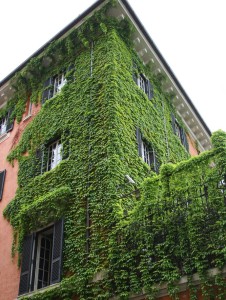The Ivy League

Aesthetics notwithstanding, there are potential problems associated with ivy-covered walls.
* Tenrils of ivy will find & enter cracks/breaks in masonry. As the tendrils grow, they can exert enough pressure to break or dislodge bricks & mortar. This is especially true for older masonry, which tends to be softer than the more modern materials. Ivy shoots can also intrude beneath and damage shingles, slates, copings and other roof components.
* Ivy shades building elements from sunlight and wind, which can retard evaporation of water from building surfaces. That can accelerate decay of wood elements and/or promote the growth of mold
* Covered surfaces cannot be easily inspected, maintained and repaired
* Ivy provides a safe harbor for insects and other vermin.
* Ivies of the type associated w/building adornment are invasive and opportunistic. They will overwhelm and displace other plantings if allowed to grow unchecked.
* While ivy may not be a suitable dressing for all buildings, the potential problems can be effectively managed in many instances. Conscientious maintenance will minimize the potential for damage. What’s more, removing established ivy from buildings can cause more problems than the ivy itself. Ivy’s attachment to surfaces is tenacious and remnants can remain visible decades after the plants are gone. The remnants are also resistant to “masonry-friendly” cleaning efforts. Aggresive cleaning can discolor and/or phyically damage building surfaces.
The bottom line is, if you love your ivy-covered walls, keep them. Just be prepared to expend the effort and money needed to keep the plants in check and your building protected!
